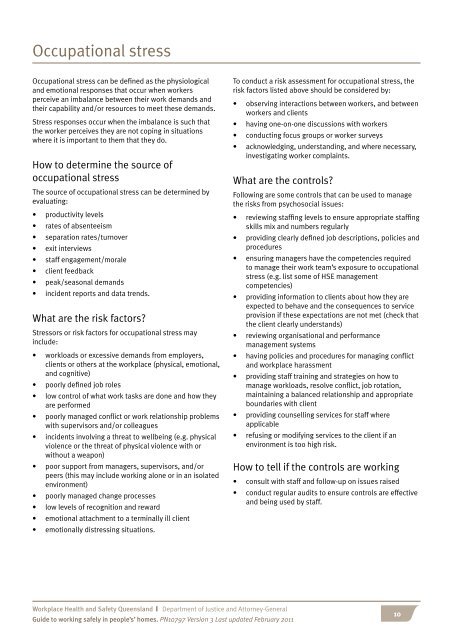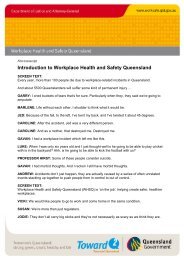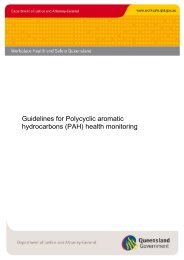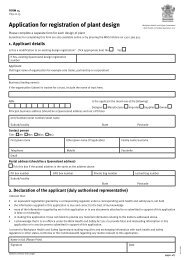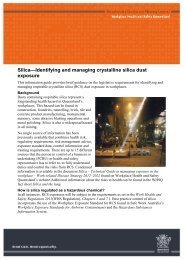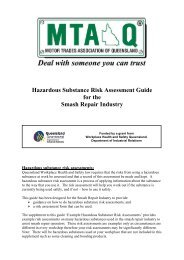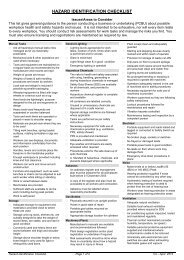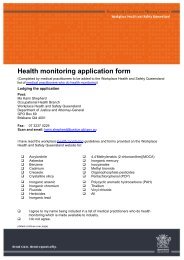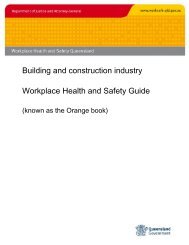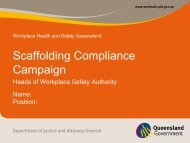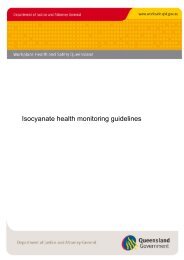Guide to working safely in people's homes - Queensland Government
Guide to working safely in people's homes - Queensland Government
Guide to working safely in people's homes - Queensland Government
Create successful ePaper yourself
Turn your PDF publications into a flip-book with our unique Google optimized e-Paper software.
Occupational stress<br />
Occupational stress can be def<strong>in</strong>ed as the physiological<br />
and emotional responses that occur when workers<br />
perceive an imbalance between their work demands and<br />
their capability and/or resources <strong>to</strong> meet these demands.<br />
Stress responses occur when the imbalance is such that<br />
the worker perceives they are not cop<strong>in</strong>g <strong>in</strong> situations<br />
where it is important <strong>to</strong> them that they do.<br />
How <strong>to</strong> determ<strong>in</strong>e the source of<br />
occupational stress<br />
The source of occupational stress can be determ<strong>in</strong>ed by<br />
evaluat<strong>in</strong>g:<br />
• productivity levels<br />
• rates of absenteeism<br />
• separation rates/turnover<br />
• exit <strong>in</strong>terviews<br />
• staff engagement/morale<br />
• client feedback<br />
• peak/seasonal demands<br />
• <strong>in</strong>cident reports and data trends.<br />
What are the risk fac<strong>to</strong>rs?<br />
Stressors or risk fac<strong>to</strong>rs for occupational stress may<br />
<strong>in</strong>clude:<br />
• workloads or excessive demands from employers,<br />
clients or others at the workplace (physical, emotional,<br />
and cognitive)<br />
• poorly def<strong>in</strong>ed job roles<br />
• low control of what work tasks are done and how they<br />
are performed<br />
• poorly managed conflict or work relationship problems<br />
with supervisors and/or colleagues<br />
• <strong>in</strong>cidents <strong>in</strong>volv<strong>in</strong>g a threat <strong>to</strong> wellbe<strong>in</strong>g (e.g. physical<br />
violence or the threat of physical violence with or<br />
without a weapon)<br />
• poor support from managers, supervisors, and/or<br />
peers (this may <strong>in</strong>clude <strong>work<strong>in</strong>g</strong> alone or <strong>in</strong> an isolated<br />
environment)<br />
• poorly managed change processes<br />
• low levels of recognition and reward<br />
• emotional attachment <strong>to</strong> a term<strong>in</strong>ally ill client<br />
• emotionally distress<strong>in</strong>g situations.<br />
Workplace Health and Safety <strong>Queensland</strong> | Department of Justice and At<strong>to</strong>rney-General<br />
<strong>Guide</strong> <strong>to</strong> <strong>work<strong>in</strong>g</strong> <strong>safely</strong> <strong>in</strong> people’s’ <strong>homes</strong>. PN10797 Version 3 Last updated February 2011<br />
To conduct a risk assessment for occupational stress, the<br />
risk fac<strong>to</strong>rs listed above should be considered by:<br />
• observ<strong>in</strong>g <strong>in</strong>teractions between workers, and between<br />
workers and clients<br />
• hav<strong>in</strong>g one-on-one discussions with workers<br />
• conduct<strong>in</strong>g focus groups or worker surveys<br />
• acknowledg<strong>in</strong>g, understand<strong>in</strong>g, and where necessary,<br />
<strong>in</strong>vestigat<strong>in</strong>g worker compla<strong>in</strong>ts.<br />
What are the controls?<br />
Follow<strong>in</strong>g are some controls that can be used <strong>to</strong> manage<br />
the risks from psychosocial issues:<br />
• review<strong>in</strong>g staff<strong>in</strong>g levels <strong>to</strong> ensure appropriate staff<strong>in</strong>g<br />
skills mix and numbers regularly<br />
• provid<strong>in</strong>g clearly def<strong>in</strong>ed job descriptions, policies and<br />
procedures<br />
• ensur<strong>in</strong>g managers have the competencies required<br />
<strong>to</strong> manage their work team’s exposure <strong>to</strong> occupational<br />
stress (e.g. list some of HSE management<br />
competencies)<br />
• provid<strong>in</strong>g <strong>in</strong>formation <strong>to</strong> clients about how they are<br />
expected <strong>to</strong> behave and the consequences <strong>to</strong> service<br />
provision if these expectations are not met (check that<br />
the client clearly understands)<br />
• review<strong>in</strong>g organisational and performance<br />
management systems<br />
• hav<strong>in</strong>g policies and procedures for manag<strong>in</strong>g conflict<br />
and workplace harassment<br />
• provid<strong>in</strong>g staff tra<strong>in</strong><strong>in</strong>g and strategies on how <strong>to</strong><br />
manage workloads, resolve conflict, job rotation,<br />
ma<strong>in</strong>ta<strong>in</strong><strong>in</strong>g a balanced relationship and appropriate<br />
boundaries with client<br />
• provid<strong>in</strong>g counsell<strong>in</strong>g services for staff where<br />
applicable<br />
• refus<strong>in</strong>g or modify<strong>in</strong>g services <strong>to</strong> the client if an<br />
environment is <strong>to</strong>o high risk.<br />
How <strong>to</strong> tell if the controls are <strong>work<strong>in</strong>g</strong><br />
• consult with staff and follow-up on issues raised<br />
• conduct regular audits <strong>to</strong> ensure controls are effective<br />
and be<strong>in</strong>g used by staff.<br />
10


